Abstract
This article explores the significance of simulation-based analysis in understanding the effectiveness of material handling strategies. By utilizing simulation models, businesses can optimize production processes, streamline flows, and enhance overall logistics efficiency. In today’s competitive market landscape, the significance of product manipulation cannot be overstated. It directly influences consumer perception and plays a pivotal role in gaining a competitive advantage. Simulation-based analysis has emerged as a powerful tool for optimizing production processes and enhancing logistics efficiency. Robotics sorting and loading offer increased accuracy, speed, and efficiency over manual processes. Their implementation boost productivity, cuts costs, and enhances working conditions. In today’s competitive market, effective product handling shapes consumer perception and competitiveness. VR simulation-based analysis optimizes manufacturing, logistics, and robotics, driving efficiency. Through advanced VR simulation models, businesses streamline operations, adapt to market dynamics, and embrace automation, enhancing competitiveness.
1. Introduction
In today’s dynamic and hyper-competitive market environment, where customer preferences evolve rapidly and market trends fluctuate unpredictably, mastering the art of product manipulation appears to be a critical imperative for businesses seeking to gain a distinct and enduring presence. Encompassing a myriad of strategies from packaging design to pricing tactics, product manipulation is a strategic cornerstone for companies aiming to influence consumer perception, stimulate demand, and gain competitive advantages in the marketplace. Understanding the complex dynamics of product handling is therefore key to unlocking new avenues of growth, fostering brand loyalty and ultimately achieving sustainable success. In this context, this article embarks on a comprehensive exploration of the deep significance of simulation-based analysis in elucidating the effectiveness of various product manipulation strategies. By diving deep into the realm of simulation, businesses gain access to a powerful toolset that allows them to simulate real-world scenarios, experiment with different manipulation tactics, and predict the consequences of their strategic decisions with unmatched accuracy and insight. By leveraging advanced simulation techniques, companies can distil complex data sets, spot emerging patterns, and derive actionable insights about consumer behaviour, market dynamics, and competitive forces. Through a detailed review of case studies and a robust theoretical framework, this article clarifies how simulation serves as a cornerstone for optimizing product handling tactics. By illuminating the transformative potential of simulation in informing strategic decision-making, mitigating risk and seizing new opportunities, this discourse seeks to equip businesses with the knowledge and tools needed to navigate the complex maze of product manipulation with confidence and foresight. As businesses strive to adapt and thrive in an increasingly complex and uncertain environment, simulation becomes and essential ally that enables companies to chart a course for sustained growth, competitive differentiation, and sustained success. According to Acropolium, in 2023, more than 90% of organizations said that they plan to integrate or are already implementing new technology in logistics or in their supply chain operations. That is the reason why, upon the start of 2024, it is therefore necessary for all advanced solutions to grow exponentially, which can actually be seen in the market changes themselves [1]. A study by McKinsey found that on the back of technology investment, taking into account investments from 2020, investments either remained stable or increased. Thus, the options for companies that cannot, do not want, or do not have the opportunity to modernize and thus lag behind, are significantly narrowed. But in 2024, businesses have an opportunity to make their supply chain more resilient by implementing resources to strengthen their ability to thrive in the face of the challenges of ever-faster deliveries, the rise in e-commerce, and skilled labour shortages. According to the study, this technology race is currently gaining momentum and logistics companies are investing technology to reduce costs and increase productivity in their warehouses and transport networks to demonstrate their competitiveness in the market. In addition to gaining the competitive advantage with it, they expand not only their capabilities, but also ensure the fact this change will be sustainable over time [2]. If we look at the logistics trends of recent years, in each list, which is more or less the same, we find that a great emphasis is placed on digitization, its power and potential. Amidst the complexity of a world grappling with economic uncertainty and environmental challenges, the field of engineering simulation is a testament to human ingenuity and resilience. By developing digital twins into executable versions and integrating artificial intelligence and machine learning, engineers are equipped with powerful tools to navigate turbulent waters. In the midst of these global challenges, engineering simulation appears as a beacon of hope that fosters innovation and resilience. From the evolution of digital twins to the integration of AI (artificial intelligence) and ML (machine learning), each advancement brings us closer to a future of uncertain times, and these developments remind us of the power of human ingenuity and the limitless potential of collaboration. Model-based systems engineering offers a holistic approach to managing the complexity of modern products, supporting better decision-making and optimizing performance. Fuelled by simulation-driven innovation, additive manufacturing and generative design promise to revolutionize manufacturing, realizing the long-term vision of simulation-optimized products without traditional limitations. Perhaps most inspiring is the dawn of digital materials, which opens up unprecedented collaboration between disciplines and offers tailor-made solutions to pressing challenges. As we embark on this journey of technological advancement, these developments serve as a reminder of the endless potential of human creativity and collaboration to create a brighter and more sustainable future [3].
2. Literature Review
In today’s dynamic product and service markets, characterized by numerous participants, companies must continually assess and monitor their performance to remain competitive. Depending on industries and systems, there are various performance metrics, with efficiency being one of the fundamental and commonly used indicators. However, there’s no universally accepted definition, as it varies among authors and differs between manufacturing and service companies. Efficiency measurement in logistics is particularly significant in recent years, with various aspects to consider. Depending on the timing and importance of decision-making, efficiency measurement occurs at three hierarchical levels: strategic, tactical, and operational. Within logistics, efficiency can be measured across different aspects such as activities, processes, subsystems, systems, and supply chains. Efficiency measurement and monitoring in logistics encompass both forward and reverse logistics flows, which is depicted in Figure 1. It is essential to analyse logistics activities and processes even in systems not primarily focused on logistics services [4].
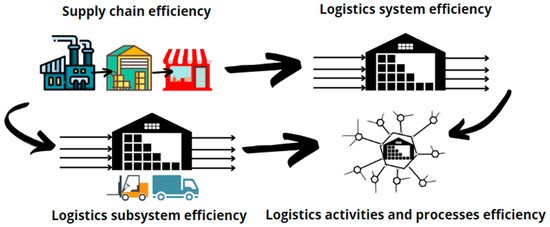
Figure 1.
Efficiency measurement and monitoring in logistics [4].
Material handling plays a pivotal role in logistics and manufacturing industries, constituting a significant portion of operations. In manufacturing, the time allocated to product handling and transportation often rivals that of value-added processes. According to Banks and others [5], material handling accounts for approximately 85% of total manufacturing time. Therefore, the ability to analyse and assess material handling systems is crucial for decision-making to enhance material flow management and optimize manufacturing and distribution operations. However, these systems, characterized by complex interactions among components and uncertainties in the real world, pose challenges for analytical methods. Hence, computer-based simulation modelling emerges as a more effective and efficient solution. Unlike mathematical models, simulation can handle various complex factors encountered in real-world scenarios. Moreover, the performance measures derived from simulation models generally exhibit higher accuracy compared to analytical methods, which often rely on unrealistic assumptions. Across various domains such as engineering, finance, and business, many real-life problems can be framed as optimization problems. These entail finding the best possible solutions(s) to meet specific criteria. With advancements in simulations tools, decreasing costs of computational power, and the development of specialized simulation languages and tools, simulation modelling has become a widely accepted approach for system analysis and solving optimization problems [6]. In business management, waste is predominantly associated with quality management techniques, representing a decline in efficiency or economy. Waste encompasses anything that does not add value or contributes to losses. In the production sector, various types of waste are identified:
- Overproduction (resulting in losses, poor quality, lack of transparency, and problem concealment);
- Waiting (caused by machine breakdowns, material delays, testing delays, or awaiting subsequent steps);
- Excessive transportation and handling (attributed to poor layout or material disposition);
- Unnecessary movements (arising from poorly organized workplaces or processes);
- Unnecessary processes and operations (e.g., idle machines);
- Error rates (resulting in additional transport, inspection, or production of defective parts);
- Untapped human potential (stemming from worker dissatisfaction or loss of motivation);
- Poor communication (due to lack of information, concealment, or unclear strategy).
To mitigate waste within companies, numerous methods and logistics systems have been devised to streamline operations and eliminate inefficiencies [7].
Addressing customer needs and meeting expectations while establishing objectives is paramount. In achieving this, maintaining a continuous production schedule assumes considerable importance and is central to this efficient material handling, encompassing the strategic planning of procurement, receiving, sorting, and delivery of materials for consumption in production, all underpinned by effective control measures [8,9]. It is evident that industrial goods, serving as inputs for other physical products, constitute materials subject to management, known as material handling [9,10]. Material handling encompasses all activities, tasks, and processes involved in the transfer of external materials and services into the organization [9,11]. Optimal material handling serves as a tool to enhance organizational efficiency by importing skills in reducing defective products, shortening operating cycles, lowering handling costs, eliminating unproductive material handling, reducing idle machine capacity, and mitigating factory hazards [9,12]. Logistics facilities are interpreted as transshipment terminals, distribution or production sites, but all of them have one shared goal, and that is global optimization [13]. Boosting productivity remains the primary challenge for companies striving to compete in the global market. Productivity in industrial enterprises relies on efficiency, which encompasses the resources needed to achieve desired outcomes including time, financial investments, and energy expended during the production process. Efficiency, in essence, reflects the ability to meet social needs and incorporates the economic contributions of staff members. It manifests across various production stages and can be measured through multiple metrics. It is essential to distinguish between efficiency, effectiveness, and productivity, as productivity evaluation integrates efficiency. Productivity, gauged by the ratio of actual output to input, directly influences both efficiency and effectiveness. For instance, equipment efficiency indicates the cost-effective operation, measured by the ratio of outputs to inputs. Every company strives to minimize costs, maximize performance, and optimize assets. For manufacturing firms, solutions enhancing production efficiency have become paramount. Overall equipment efficiency (OEE) serves as a pivotal performance indicator, enabling the measurement and comparison of individual production equipment efficiency within a company. It aids in monitoring and enhancing the production process, identifying and addressing losses, monitoring order progress, and conserving energy and human resources. OEE calculation provides a clear quantitative tool for assessing productivity, which is illustrated in Figure 2. By pinpointing areas for improvement and promoting transparency, it contributes to optimizing equipment efficiency, thereby enhancing overall operational performance [14].

Figure 2.
Overall equipment efficiency (OEE) calculation [14].
Availability encompasses both planned and unplanned downtime during production. Performance factors include slowed cycles or minor interruptions in production. Quality addresses errors requiring rework. OEE integrates all these losses. A perfect OEE score of 100% signifies a production process aligned with quality standards, operating at maximum speed, and without any downtime; the comparison in percentage is shown in Figure 3. However, OEE values may vary due to efficiency fluctuations in businesses [14]. Facilities planning is a multifaceted process influenced by various factors and variables, some of which may not always align and could even contradict each other, impacting decision-making. Manufacturing facility design involves organizing a company’s physical assets to optimize the efficient utilization of resources like people, materials, equipment, and energy. This encompasses plant location, building design, plant layout, and material handling systems. Decision regarding plant location strategy are typically made at the corporate level and may not always prioritize operational efficiency, often influenced by non-engineering factors. However, manufacturing facilities’ design and material handling significantly impact a company’s productivity and profitability. Improvements in material handling have notably benefited workers and ergonomics. Every expense in business, including material handling equipment, must be justified in terms of cost. Funds allocated for material handling equipment should ideally be recovered within two years, yielding a return on investment (ROI) of at least 50%.
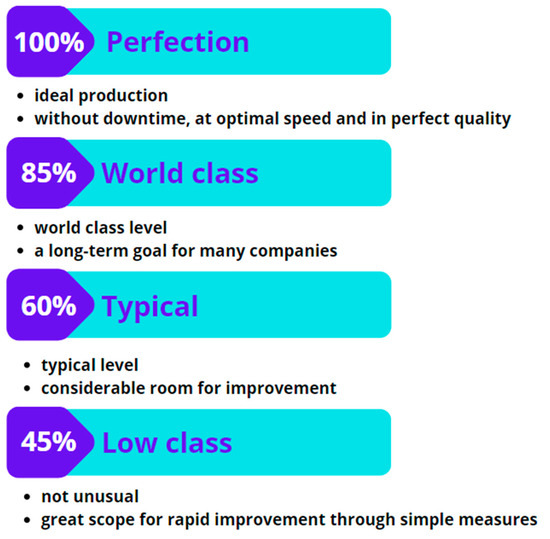
Figure 3.
Overall equipment efficiency (OEE) values [14].
Material handling and facility planning are closely intertwined, with material handling equipment selection influencing facility layout. The construction of a new manufacturing plant is one of the largest expenses for a company, and the layout decision made will affect employees for years to come. Improving material flow can lead to automatic reductions in production costs, as shorter flow paths through the plant are associated with cost savings. Material handling accounts for a significant portion of industrial injuries and operating costs. However, investing in proper material handling equipment can yield a positive ROI. Additionally, modern material handling systems can incorporate cutting-edge technologies for automatic data capture and inspection, enhancing quality and productivity. Production goals and objectives should align with the corporation’s mission statement. Subgoals are added to help achieve specific objectives, which may include minimizing unit and project costs, optimizing quality, promoting effective resource utilization, ensuring employee safety and comfort, controlling project costs, and meeting production start dates. Material handling entails the precise movement of materials to ensure they reach the correct destination at the right time, quantity, sequence, and condition, thereby minimizing production costs. Modern material handling systems rely on various control systems, including part numbering, location, inventory control, standardization, lot size, order quantities, safety stocks, labelling, and automatic identification techniques such as barcoding, to keep industrial plants’ materials flowing efficiently. Broadly defined, material handling encompasses all material movements within manufacturing environments, including transportation or transfer between points. Efficiency and safety are paramount concerns in this regard, with the quantity per move dictating the type and costs of material handling equipment. The time dimension determines how swiftly materials move through the facility, impacting work in process, inventory levels, handling frequency, and order delivery lead times. Space considerations involve storage for equipment and materials, as well as staging areas for material movement. Control aspects encompass material tracking, positive identification, and inventory management, all of which are critical for effective material handling. Material handling is closely intertwined with plant layout, and thus changes to one will invariably affect the other. While material handling equipment has reduced labour and production costs and enhanced work quality, it also accounts for a significant portion of industrial accidents. While it can eliminate manual lifting, proper safety measure must be prioritized by project engineers. On average, material handling represents 50% of total operation costs, rising to 90% in certain industries like mining. Consequently, industrial managers and facility designers must carefully consider safety, quality, labour, power, and equipment costs to determine overall unit costs [15]. Modelling and simulation serve as invaluable tools for planning, designing, and evaluating dynamic systems, as well as assessing strategies for system transformation and change. There are numerous reasons for undertaking modelling and simulation studies; below are some of the most common ones:
- Comparison of control policy options;
- Education and training;
- Engineering design;
- Evaluation of decision or action alternatives;
- Evaluation of strategies for transformation or change;
- Forecasting;
- Performance evaluation;
- Prototyping and concept evaluation;
- Risk/safety assessment;
- Sensitivity analysis;
- Support for acquisition/procurement decisions;
- Uncertainty reduction in decision-making.
Simulation models and languages must meet elevated standards, particularly regarding interoperability and reuse, yet comprehensive guidance on modelling and specifying simulation standards is lacking. With the rapid advancement of computer science and technology, simulation technology is permeating various sectors, notably industry, transportation, electric power systems, military, and networking. Consequently, simulation techniques have become pivotal in supporting the development of diverse industries due to their ability to swiftly predict and validate reliability. The simulation life cycle encompasses a series of stages from initial design, model customization, and preprocessing to model verification and final results. This life cycle serves as a framework to guide the design of specific simulation fields, enabling simulation professionals to develop comprehensive and efficient simulation models tailored to their respective domains [16]. The specific goal of a simulation project significantly influences the nature of the evolving model. However, it is crucial to acknowledge that these goals may be considered by limitations on available knowledge about system under investigation (SUI). The level of knowledge about the underlying dynamics of systems varies widely, which inevitably impacts the constraints placed on the project’s goals [17]. In today’s context, simulation systems are regarded as valuable aids for both production logistics and the broader logistics process. They excel in streamlining flows, providing a detailed analysis and monitoring of production, and facilitating comprehensive production planning and management [18]. Simulation-based analysis entails constructing virtual environments or models that mirror real-world situations [19]. By incorporating pertinent variables and parameters, such as consumer demographics, market trends, and competitor actions, businesses can simulate diverse product manipulation scenarios and gauge their potential repercussions. Utilizing advanced algorithms and predictive modelling methods, simulations empower companies to anticipate consumer behaviour, predict market trends, and evaluate the efficacy of various manipulation strategies. Design optimization methods typically comprise two components: design methods with analysis models and optimization methods with algorithms. Broadly, classical optimization methods fall into two categories:
- Direct optimization methods;
- Optimization methods based on approximate models.
Approximate models can mitigate the nonlinearity of optimization problems, thus substantially enhancing optimization efficiency [20].
3. Theoretical Framework
Across multiple industry reports and insights, the prevalent trends of digitization, automation, and robotics are highlighted as transformative forces shaping the future of the shipping and logistics sector:
- Digitization: The adoption of digital technologies such as IoT (Internet of Things), AI (artificial intelligence), and blockchain is revolutionizing supply chain management, enhancing visibility, and optimizing operations. Companies are leveraging digital platforms for real-time tracking, predictive analytics, and seamless communication among stakeholders.
- Automation and Robotics: Automation technologies, including autonomous vehicles, robotic arms, and warehouse automation solutions, are driving efficiency, productivity, and cost-effectiveness in logistics operations. Tasks such as order picking, packing, and sorting are being streamlined through automation, leading to faster fulfilment times and reduced errors.
- Supply Chain Resilience: Heightened awareness of supply chain vulnerabilities following disruptions like the COVID-19 pandemic has prompted companies to prioritize resilience through digitization, automation, and risk management strategies. The focus is on building agile and adaptable supply chains capable of responding to dynamic market conditions.
- Sustainability: Environmental sustainability is emerging as a key priority for the logistics industry, with companies adopting eco-friendly practices and technologies to reduce carbon emissions and minimize environmental impact. Digitization and automation play a crucial role in optimizing routes, reducing fuel consumption, and enhancing sustainability across the supply chain.
- Talent Development: The evolving nature of logistics operations requires a skilled workforce equipped with digital literacy and technical expertise. Companies are investing in talent development and upskilling initiatives to meet the demands of emerging technologies and ensure workforce readiness for future challenges.
These trends underscore the transformative potential of digitization, automation, and robotics in reshaping the shipping and logistics landscape, driving innovation, efficiency, and sustainability in an increasingly digital and interconnected world [21]; some of the automation trends are shown in Figure 4.

Figure 4.
Automation across global logistics chain [21].
The rapid advancement of technology in recent decades has fundamentally transformed our daily lives. At the forefront of this transformation is the fourth industrial revolution, known as Industry 4.0, which aims to revolutionize manufacturing by creating interconnected and intelligent machines. The primary objective of Industry 4.0 is to establish “smart factories” and “cyber-physical systems” (CPSs). In smart factories, autonomous machines play a pivotal role, capable of handling routine tasks and making decisions even in exceptional circumstances. Industry 4.0 encompasses a wide array of technologies, including big data analytics, autonomous robotics, simulation, horizontal and vertical integration, the industrial Internet of Things, cybersecurity, cloud computing, additive manufacturing, and augmented and virtual reality (AR/VR). These technologies collectively enable the development of highly efficient and adaptive manufacturing processes, driving innovation and competitiveness in the global market [22]. The global adoption of robots across the industries is steadily increasing, driven by their unique capabilities and efficiency. Robots, alongside human workers, offer complementary strengths and limitations. Collaboration between humans and robots in a safe environment leads to the production of higher quality products with precision and efficiency within shorter timeframes. In the current landscape, where individuals are often engaged in demanded tasks for extended periods, the distinction between human and machine roles become blurred. The integration of machines expedites various processes, allowing tasks to be completed more swiftly. As competitiveness intensifies in the business sphere, the necessity for astute decision-making grows, necessitating the development of smarter systems capable of making informed decisions promptly. Traditionally, robots have been utilized for specialized tasks in manufacturing processes, while humans are allocated roles such as quality inspection and defect identification. However, modern robotics emphasizes safety, flexibility, and collaboration, enabling intelligent task execution alongside human counterparts. Looking ahead, the integration of artificial intelligence and advancements in robotics will significantly transform society. These technologies are reshaping manufacturing and production, driving automation to enhance productivity and bolster economic growth. The future promises a society shaped by the integration of robotics and industrial automation, marking a significant shift in production paradigms [23]. Simulation studies have been a prominent feature in robotics research, serving diverse epistemic and practical objectives. This discussion delineates two overarching categories of simulation studies within robotics. The first category involves using robotic systems to gain insight into biological systems, while the second category employs artificial systems, such as programmed computers, to assess the performance of robotic systems. There are several compelling reasons to pursue this goal. Firstly, the existing literature on simulations has primarily focused on domains outside of robotics, such as atmospheric, economic, physical, and social phenomena. As a result, there is a gap in the philosophical discourse surrounding robotic simulations on whether such simulations can contribute to clarifying the terminology and methodological framework employed in simulation studies within the field of robotics, and whether they can facilitate the identification of methodological challenges and the cross-pollination of solutions between different areas of research [24]. The advent of Industry 4.0 has brought about significant transformations in manufacturing, aiming to produce cutting-edge, high-quality products with shorter time-to-market intervals, facilitated by enhanced flexibility and real-time knowledge exchange throughout the product development lifecycle. In response to the demands of discerning customers seeking a variety of product variants tailored to their preferences and budgets, manufacturing industries are compelled to adapt by fostering greater flexibility in both design and production processes. Consequently, manufacturers are reassessing their manufacturing methodologies to align with the standards set by Industry 4.0. Immersive technologies, such as augmented reality (AR) and virtual reality (VR), are increasingly being leveraged to assist workers in overcoming challenges and obstacles, offering support, simulation, and guidance to enhance industrial processes before their implementation in manufacturing environments. This integration of immersive technologies is poised to yield significant cost savings by mitigating the need for reworking and revising manufacturing activities, including product design, process planning, and machining. Originally utilized by retailers for promotional purposes, AR and VR have undergone significant advancements in software algorithms and cost reduction for devices, leading to their widespread adoption across various industries. In the manufacturing sector, the focus of AR/VR implementation has shifted towards guiding and training semi-skilled workers to execute complex tasks efficiently. VR, in particular, offers users a fully immersive experience by transporting them from the physical environment to a virtual realm, stimulating all human senses, including sight, hearing, touch, taste, and smell. Through VR technology, users can engage in visualizing, manipulating, and interacting with computer-generated elements within a realistic virtual environment. Furthermore, VR facilitates interactive, realistic simulations incorporating non-visual modalities such as tactile, audio, and haptic feedback, enhancing the user’s perception of presence within the virtual environment [25].
3.1. Related Works
In logistics, intralogistics plays a crucial role in managing processes within warehouses and distribution centres to ensure efficient material and information flow. Among these processes, order picking stands out as fundamental, constituting around 55% of warehouse operating costs. Given the demand for high throughput, especially with the rise in individualized orders and faster delivery times, warehouse automation becomes imperative [26].
3.1.1. Simulation Model for Robotic Pick-Point Evaluation
In 2023, the authors Bencek, Hercog, and Lerher [26] developed a study related to the simulation for robotic pick-point evaluation for a 2-F robotic gripper. Robotic bin picking systems aim to minimize human intervention by utilizing robotic arms, vision systems, grippers, and control systems to handle bulk items. However, the complexity arises when dealing with items of varying shapes, colours, weights, and mechanical properties. Robotic bin picking involves several key steps: object detection, localization, grasp detection, path planning, and object manipulation. To address the challenges in determining pick points systematically, the article explores several research questions:
- Can ADAMS/MATLAB (co-simulation accurately determine grip quality for specific 2-F parallel robotic grippers?
- Is the simulation model adaptable for evaluating different 2-F robotic grippers or developing new variants?
- How does combining analytical and empirical approaches for grasp quality assessment compare to deep learning models in overall system performance?
While the simulation model demonstrates the ability to replicate physical systems, it relies on precise parameter settings that are challenging to verify without accurate sensors. Despite its lower accuracy compared to deep learning approaches, the simulation model provides transparency but demands longer processing time due to simulating real-world physics. Ultimately, while these analytical tools are beneficial for optimizing bin picking operations in logistics or manufacturing, they should be supplemented with quality machine vision systems for precise object detention [26].
3.1.2. Avatar Robotic Telepresence (ART)
In 2024, the authors Vaz, Kosanovic, and Oh [27] published a study that explores the potential of using AI and machine learning to optimize warehouse operations, particularly in the context of order picking. The article framework utilizes VR devices to allow human operators to control robots intuitively. A key focus is on addressing the challenge of humanoid robots handling carts, a crucial but often overlooked task in disaster response scenarios. The framework facilitates human operators in commanding the robot to work with various types of carts and grasps, as demonstrated by experiments with untrained operators. The study highlights the potential of ART to bridge the gap between human operators and robots in disaster relief efforts, with future improvements aimed at enhancing haptic feedback for operators. Not only did these tests further attest to the robustness of ART, but they also highlighted ART’s ability to allow robots to push unknown carts with high-level directions from human operators. Such technology will be improved in the future. Overall, the ART framework represents a significant advancement in enabling humanoid robots to perform tasks in a manner that mirrors human capabilities, thereby enhancing their effectiveness in real-world scenarios [27].
3.1.3. Usability and User Experience of AR Applications in VR Simulation
Lacoche, Villain, and Foulonneau explored the assessment of usability and user experience (UX) in augmented reality applications using VR simulations. They noted the advantages of validating AR applications in VR simulations, which can expedite development processes and eliminate the need for constant physical access to real environments. VR simulations enable developers to experiment with various devices, isolate test parameters, and save on physical navigation. While the functional testing validity in VR simulations is generally accepted, the validity of evaluating user experience and usability comparable to real-world conditions requires further examination. The authors conducted a user study to investigate this validity of and the importance of simulation fidelity. They also explored the necessity of simulating the limited field of view of AR glasses and whether the virtual world must replicate the real target environment. Their study involved an AR application for smart homes, where users interacted with connected objects. One group used AR glasses in a real location, while three other groups used VR with different simulation conditions. Both subjective feedback and quantitative user results revealed minimal differences between real conditions and VR simulations, regardless of the simulation parameters. These findings suggest the potential of using VR simulations to evaluate AR applications, although further validation across different scenarios and interactions is necessary [28].
4. Case Study
This case study is the result of a collaboration with the Zeta Company, which specializes in the production of refrigeration products with an emphasis on product quality, positioning itself as a leading supplier of compressors for commercial refrigeration and condensing units. Together with investors, the company launched a project to optimize production processes at each workplace globally, with optimization also effecting the remaining (subsequent) workplaces or workstations globally. A main part of the investigation by the company was the improvement of the production process of rotors, whereby at a specific workplace, the company produces three types of rotors, divided by size. But work such as the production of rotor pockets, material storage or rotor assemblies, and compressor production lines are also related to this process. Therefore, the company divided the project into subtasks and goals and assigned individual workstations to predetermined project teams, which were responsible for finding the best solution on each workstation, contributing to global optimization. Our task was to analyse the current status of the workplace on the Z line, which carries out the production of rotor pockets. The aim is to obtain and prepare the necessary data for the proposal to improve efficiency and then validate the proposed measures to achieve global optimization. To achieve this goal, we use Visual Component Premium 4.8 simulation software as a tool to experiment and verify the obtained data and represent them with a VR model if necessary. Data were collected through detailed observation and interviews with employees as well as a thorough review of the data obtained by the company.
4.1. Production Process and Its Necessities
The manufacturing process for these inspection involves the production of rotor pockets, which are treated as blanks and then forwarded to the next workstation to assemble the rotors. The production process runs 24 h a day and is divided into three shifts of 8 h each, with 1 h each shift serving as the insured value of the inventory. Material and information flows are managed according to JIT principles and the company manages it through an internal network with real-time connections to suppliers and customers. Control is performed by reading the code of the executed process, or directly by reading individual products, materials or semi-finished products. The structure of production line Z, shown in Figure 5, is used to describe and analyse the current status, and also represents the conceptual model for the subsequent design of the simulation model itself. At workplace Z, the production target is to grind the input material in the form of 8 kg aluminium blocks (or ingots—there is no difference) as the raw material for the rotor slots. It is important to maintain the quality of the input material in the form of 99.97% aluminium, otherwise, not only the quality of the product itself, but also its production process would be at risk, since this parameter is important when cooling the product. The production process begins by transporting aluminium ingots via a conveyor belt connected to an input material warehouse, where the company melts the incoming 900 kg of aluminium ingots into the required 8 kg aluminium ingots. The operator then feeds the block into a CNC milling machine. The CNC milling machine programme for a specific shift is determined by the programmer in the scheduler section based on the production plan for each period. After the milling process, the rotor pockets are transferred to another conveyor belt for cooling and marking the final stage of production of rotor pockets. The cooling process is meticulously orchestrated under a veil of secrecy, with temperature parameters carefully guarded as proprietary knowledge, bestowing upon the company a competitive edge withing the market. Following the completion of this phase, human operators delicately transfer the rotor pockets back to their respective handling units. These encased components are subsequently entrusted to a sophisticated logistics train, meticulously choreographed to navigate the intricate pathways traversing the company’s premises. Operating within this workstation are stringent constraints, including predetermined production timelines for the milling of rotor pockets, the perpetual motion of materials along belt conveyors fixed in place by the company, and the exacting adherence to precise technological protocols and quality standards. Furthermore, meticulous attention is devoted to ensuring compliance with technical specifications governing production. The layout depicted in the visual representation of the Z production line in Figure 5 serves a dual purpose: elucidating the current operational framework while also furnishing a conceptual blueprint for the subsequent development of the simulation model itself.
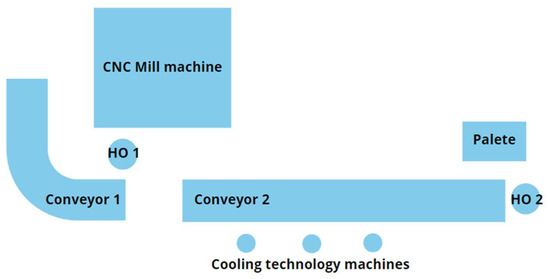
Figure 5.
Workplace layout scheme.
4.2. Simulation Model
The model of the Z production line was meticulously crafted within the simulation software Visual Components Premium 4.8, leveraging both company data and insights gleaned from a thorough analysis of the current operational landscape. The depicted model in Figure 6 encapsulates the intricate production journey of rotor pockets within the designated workspace, incorporating all pertinent elements and stakeholders involved in this process. Notably, the simplicity of the model is deliberate, eschewing superfluous details such as spatial infrastructure and ancillary equipment. This strategic omission serves a dual purpose: facilitating the ease of integration with VR simulation models, should the need arise for enhanced realism or expanded functionality, while concurrently optimizing file size to ensure smooth technical performance. The judicious decision to forego the inclusion of peripheral elements, such as doors, lights, and flooring, is underpinned by their tangential relevance to the core simulation objectives, thus streamlining data processing and evaluation without compromising the efficacy of the proposed solution.
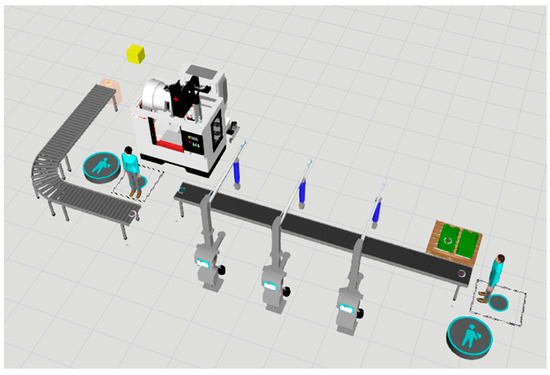
Figure 6.
Workplace layout as a simulation model.
The production process model encompasses various simulated components essential to the workflow, including belt conveyors, human operators, CNC milling machine, cooling devices, and handling units for storing and transporting finished products. To streamline the simulation and circumvent complexities associated with integrating ingot inputs arriving from another workplace, the authors opted to simplify by generating inputs directly at the Z line production. These inputs, represented by yellow cubes, are set to arrive at 250-s intervals, facilitated by the device called “Feeder”, depicted as a beige box, which ensures the regular entry of input material onto the belt conveyor. Belt conveyor no.1 transports these inputs to a human operator, controlled within the simulation using the human source controller (HSC) and idle location (IL) devices. Idle locations are represented as rectangles with a black circle, and on the contrary, HCS is represented as a black circle with a blue outline and a human logo. The HSC initiates the operation of the human operator along a predefined route, while the IL determines their starting position and return point upon route completion. The production equipment itself, namely the CNC milling machine, is not simulated in detail, as its precise operation is overseen by rained programmers. Only the duration of the milling process is specified, not the intricacies of its performance, reflecting our deference to the expertise of company personnel responsible for its optimization. Following milling, products are transferred to a second belt conveyor for cooling, where they are then loaded into pallets by a second human operator, who returns to their initial position after completing the task. Similar devices and programming principles are employed for both human operators to ensure consistency and ease of simulation.
4.3. Current State Analysis and Data Collecting
The company’s management has embarked on a mission to optimize the workstation, driven not only by the imperative of global efficiency but also by a recognition of its subpar overall performance. Additionally, the impetus for optimizing this workstation stems from the company’s overarching objectives to transition to full automation across all operations. While most processes within the company are presently automated, our workstation remains reliant on human labour for goods handling, resulting in discernible inefficiencies as depicted in the accompanying figure. The CNC milling machine, pre-programmed for continuous operation, is managed via software accessible on the company server, overseen by expert personnel stationed in the control room. Similarly, the belt conveyors operate continuously barring any breakdowns or scheduled maintenance. Human operators operating within this environment face significant ergonomic hazards compounded by the repetitive nature of their tasks and the potential for human error. It is the company’s ambition to rectify these shortcomings by proposing an optimal solution that not only enhances efficiency but also mitigates risk to human health and safety. The simulation findings reveal that Human Operator no. 1 (HO 1) has an average handling interval of 7.84 s, whereas Human Operator no. 2 (HO 2) operates with a slightly lower interval of 6.61 s. Concerning usability, HO 1 is utilized approximately 68.34% of the time, while HO 2 is engaged around 65.07% of the time. The results are shown in Figure 7 and Figure 8.
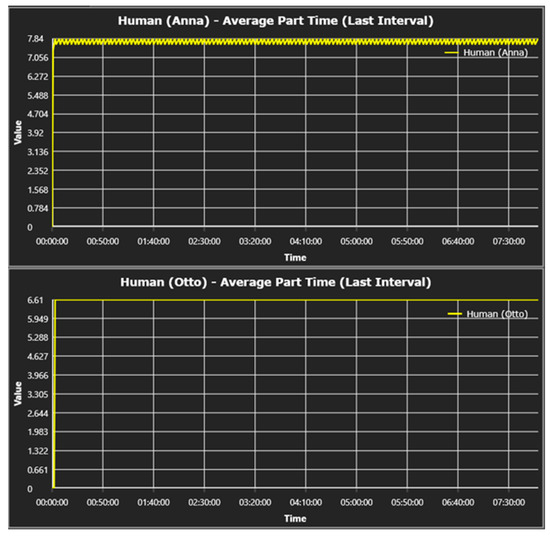
Figure 7.
Current state statistics part 1—average part time.
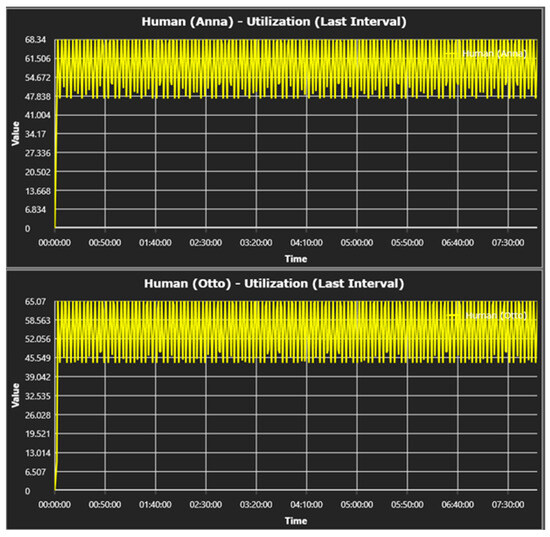
Figure 8.
Current state statistics part 2—utilization.
Earlier in the article (see: page 6, row 259), we delve into how the handling of goods not only impacts efficiency, but also influences production costs significantly. Given that handling costs typically constitute approximately 50% of overall production expenses, optimizing the goods handling process to achieve maximal efficiency with minimal costs becomes paramount. While the usability of human operators falls within the global standard range, ranging from 65% to 69%, there remains ample room for improvement in this metric. This underscores the significance and relevance of efficient material handling in today’s dynamic logistics and industrial landscape, where evolving customer demands constantly reshape market dynamics and dictate new trends. Presently, there is a heightened emphasis on expedited delivery, with automation and robotics emerging as prominent trends. The integration of robotic technologies not only in distribution centres, but also directly within production operations presents novel opportunities to enhance productivity, streamline processes, and bolster overall logistics efficiency, consequently driving down costs. Given the company’s directive towards full automation, the deployment of robots emerges as a solution to address prevailing challenges. Robotic sorting and loading offer manifold benefits, including heightened precision, speed, and overall efficiency compared to manual processes. Interviews with employees and observational insight highlight the physical strain, monotony, and repetitiveness often associated with manual sorting, leading to lapses in concentration and subsequent errors. Hence, in crafting an optimal solution, we explore alternatives ranging from semi-automation to fully automated operations to alleviate these challenges.
4.4. Simulation Modelling
Exploring various models or potential solutions to a given problem proved instrumental in identifying the optimal course of action while concurrently enhancing workplace efficiency. The pivotal decision to amend the model entailed substituting Human Operator no. 1 with a robotic arm, which you can see in Figure 9. This sophisticated robotic apparatus possesses the capability to navigate the designated area for conveying or manipulating components, thereby automating a task hitherto executed by a human operator. Nevertheless, determining the extent of the robotic arm’s efficacy vis á vis a human operator remains imperative, particularly concerning components’ material handling tasks in conjunction with a CNC milling machine.
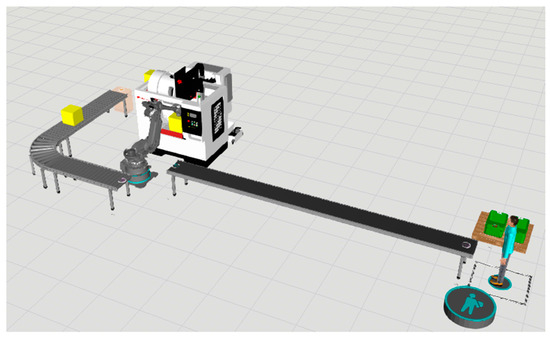
Figure 9.
First variant of simulation model.
As observed in Figure 10 and Figure 11, the human operator has been substituted with a robotic arm. Throughout the simulation process, it became imperative to gather data concerning the operational speed and usability of the robotic device, which are pivotal factors in assessing overall performance efficiency. The simulation results indicate that by implementing the proposed changes, the need for goods transportation would be entirely eliminated, reducing the handling time to just 2.38 s. This represents a significant efficiency improvement, with approximately 70% time savings compared to the previous handling time of 7.84 s. Additionally, the utilization of the robot would reach 100%, maximizing its efficiency.
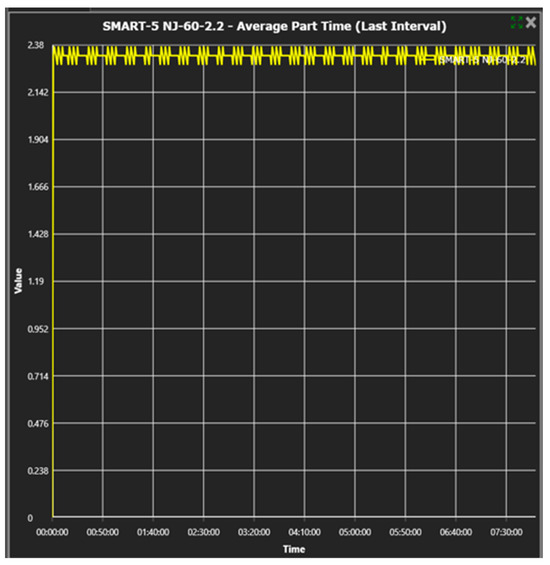
Figure 10.
Statistics of the first variant of simulation model part 1.

Figure 11.
Statistics of the first variant of simulation model part 2.
Nonetheless, the query arose regarding the necessity of retaining Human Operator no. 2 in light of the company’s objective to achieve full automation within the production process. Additionally, it was imperative to consider the evaluation of the efficiency and usability of Human Operator no. 2, which can be seen in Figure 12, and which, based on the attained results, warranted scrutiny in assessing and recommending innovations.

Figure 12.
Second variant of simulation model.
To address this dilemma, we devised a model illustrating fully automated operations, wherein we eliminated Human Operator no. 2 and substituted them with a second robotic arm. The results and parameters of the measured intervals and usability for the first robotic arm remain consistent. However, in this instance, we juxtapose the statistic of Human Operator no. 2 with a second robotic arm, as depicted in the ensuing figures. Evidently, the manipulation interval in this scenario is 2.49 s, signifying a remarkable time-saving or efficiency enhancement of 62% compared to the prior duration of 6.61 s. The results are shown in Figure 13 and Figure 14. Furthermore, akin to the initial model, the usability of the robotic arm stands at 100%, while once more, material handling is entirely obviated, aligning seamlessly with the company’s imperative for fully automated operations.
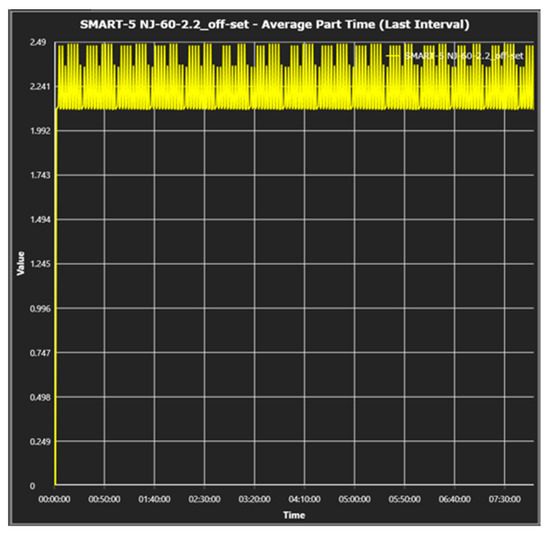
Figure 13.
Statistics of the second variant of simulation model part 1.
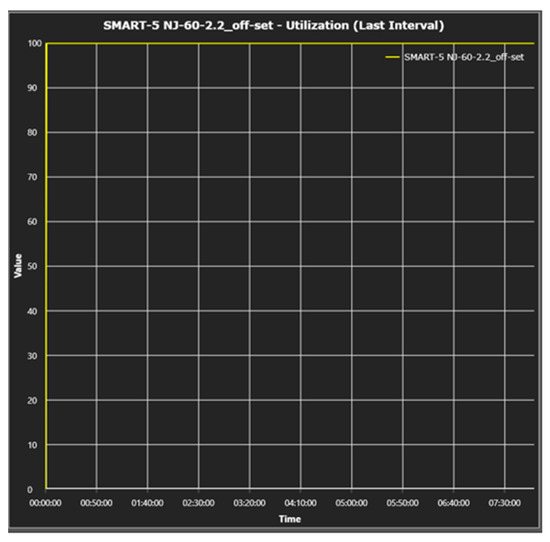
Figure 14.
Statistics of the second variant of simulation model part 2.
4.5. Data Evaluation and Conclustion
A pivotal stage of the research involved evaluating the gathered data and the outcomes of the simulations. These assessments aimed to validate the effectiveness of the proposed solutions and guide the formulation of requisite measures towards attaining the optimal solution. Throughout this process, the attained results from the existing scenario were scrutinized and juxtaposed with the latest iteration of a fully automated operation, given its superior efficiency. Comparative analyses were conducted, focusing on manipulation times and operator usability (robot vs. human operator), where comparisons are shown in Figure 15 and Figure 16.
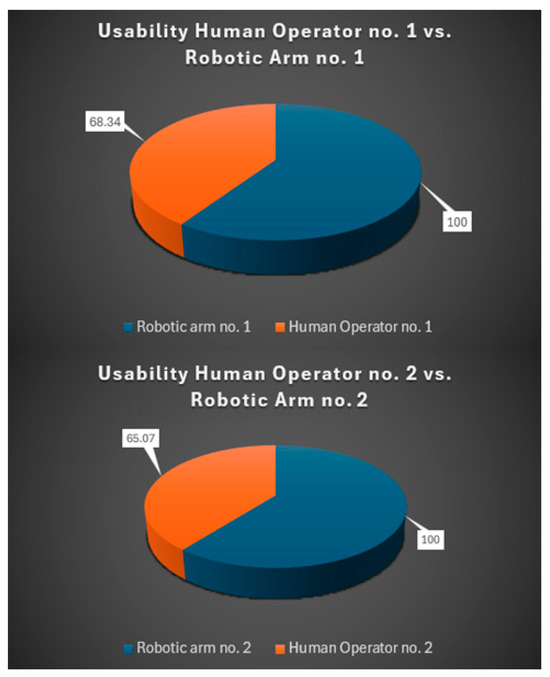
Figure 15.
Statistics comparison of human operators vs. robotic arms.
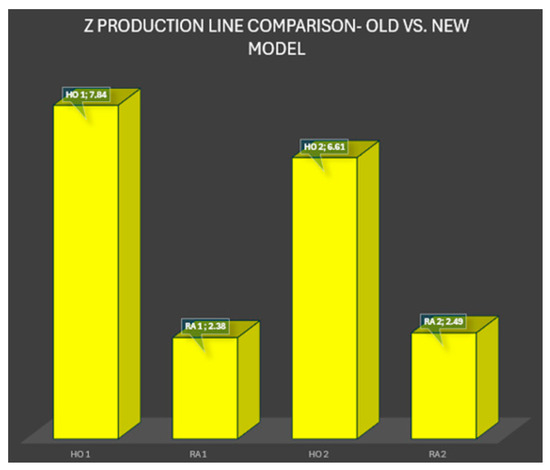
Figure 16.
Statistics comparison of new vs. old model.
Through the implementation of a newly devised manufacturing model, Zeta achieved a remarkable reduction of over 80% in the time required to handle components, transitioning to a fully automated operation devoid of human intervention. This transformation not only eradicated the need for material movement paths but also concurrently diminished safety hazards in the workplace. Simulation data underscore the effectiveness of the newly designed devices, boasting a usability rate of 100%, surpassing the approximately 30% usability rate of human operators. Despite a modest 30% increase in usability, the pivotal factor remains the time required for these actions. Notably, intervals have been drastically reduced from 7.84 s to 2.38 s and from 6.61 s to 2.49 s, representing an acceleration of 81% and 84%, respectively. Such efficiency enhancements signal a significant upsurge in the production process efficiency. These substantial savings not only unlock avenues for augmenting production efficiency in the future, but also herald new opportunities for the company.
5. Conclusions
It is widely recognized that simulation-based analyses offer significant advantages in both time-saving and cost reduction for testing and validating proposed models within the design process. Furthermore, they enable companies to circumvent direct intervention in production processes, thus averting potential disruptions to workplace operations. Moreover, there is a notable absence of risks typically associated with redesigning functional systems. The expeditious delivery of results, coupled with robust verification and validation processes, lends credibility to proposed solutions. Consequently, simulation emerges as a highly suitable tool for validating dynamic processes, such as the rotor pocket manufacturing process under evaluation. The presentation of simulation models and proposed solutions in VR serves as an invaluable aid in comprehending the proposed problem-solving approach, particularly for investors. By directly visualizing the workplace and its planned operation post-modifications, investors gain a nuanced understanding of the proposed solutions. Following the presentation of achieved results, several investors expressed particular admiration of the VR simulation model, as it provided a realistic depiction of the differences in speed between robotic and human-operated work. Notably, both VR and robotics represent trends not only of the present but also of the future, underscoring their significance in shaping the landscape of industry and innovation.
In recent years, robotics has emerged as a transformative force in logistics, reshaping traditional approaches and revolutionizing the way goods are handled, stored, and transported. With the advent of advanced robotic technologies, logistics operations have witnessed a paradigm shift towards automation, efficiency, and precision. This trend towards robotics in logistics represents a key development, driven by ever-increasing demands for speed, accuracy, and scalability in supply chain management. Robotic systems are increasingly being deployed across various aspects of logistics operations, from warehouse and distribution centres to transportation networks, offering unprecedented levels of productivity and agility. Equipped with advanced sensors, artificial intelligence, and machine learning capabilities, these robots have the ability to navigate complex environments, manipulate objects and perform tasks with unmatched speed and precision. Moreover, the integration of robotics in logistics is not limited to the automation of routine tasks, but also extends to augmenting human capabilities, increasing safety standards and optimizing the use of resources. The advantages of incorporating robotics into logistics are manifold. Improved operational efficiency, reduced labour costs, improved inventory management, and accelerated order fulfilment are just some of the benefits that robotics bring. In addition, by streamlining processes and mitigating human error, robotic systems contribute to minimizing delays, optimizing throughput and increasing overall customer satisfaction. As the logistics industry continues to embrace technological innovation, the adoption of robotics may become more widespread. From e-commerce giants to brick-and-mortar retailers, businesses across sectors are recognizing the transformative potential of robotics to optimize supply chain operation and gain a competitive advantage in today’s dynamic market environment. In this context, understanding the new trends and applications of robotics in logistics is paramount for organizations that want to thrive in the digital age. Finally, in today’s competitive business environment, it is very important for companies to be able to respond as quickly and flexibly as possible to changes in order demand. Robotics stands as a pivotal catalyst capable of reshaping companies and bolstering their competitiveness in the contemporary business landscape. By facilitating not only heightened efficiency and productivity but also enabling optimal resource utilization, robotics empowers organizations to swiftly adapt to market fluctuations and dynamics. This transformative technology equips businesses with the agility and resilience needed to navigate the complexities of today’s dynamic marketplace, thereby positioning them for sustained success and growth.
Author Contributions
Conceptualization, S.Š., M.S. and A.S.; methodology, S.Š., M.S. and A.S.; software, S.Š. and M.S.; validation, S.Š., and M.S.; formal analysis, S.Š., M.S. and A.S.; investigation, S.Š., M.S. and A.S.; resources, S.Š., M.S. and A.S; data curation, S.Š.; writing—original draft preparation, S.Š., M.S. and A.S.; writing—review and editing, S.Š., M.S. and A.S.; visualization, S.Š.; supervision, M.S. and A.S.; project administration, S.Š., M.S. and A.S; funding acquisition, S.Š., M.S. and A.S. All authors have read and agreed to the published version of the manuscript.
Funding
This research was funded by the project with grant number KEGA 010TUKE-4/2023 based on an application of educational robots in the process of teaching the study programme industrial logistics.
Institutional Review Board Statement
Not applicable.
Informed Consent Statement
Not applicable.
Data Availability Statement
Restrictions apply to the availability of these data. Data was obtained from [Zeta Company] and are available [from the author Simona Špirková] with the permission of [Zeta Company].
Conflicts of Interest
The authors declare no conflicts of interest. The funders had no role in the design of the study; in the collection, analyses, or interpretation of data; in the writing of the manuscript, or in the decision to publish the results.
References
- Acropolium.com. Available online: https://acropolium.com/blog/top-logistics-technology-trends/ (accessed on 15 March 2024).
- Mecalux.com. Available online: https://www.mecalux.com/blog/logistics-trends-2024 (accessed on 18 March 2024).
- Designnews.com. Available online: https://www.designnews.com/design-software/five-trends-that-will-define-simulation-and-test-in-2023 (accessed on 18 March 2024).
- Andrejić, M.M. Measuring efficiency in logistics. Vojnoteh. Glas. 2013, 61, 84–104. [Google Scholar] [CrossRef]
- Banks, J.S.; Carson, I.; Nelson, B.L.; Nicol, D.M. Discrete-Event System Simulation, 4th ed.; Prentice Hall: Upper Saddle River, NJ, USA, 2010. [Google Scholar]
- Leung, C.S.K.; Lau, H.Y.K. Simulation-based optimization for material handling systems in manufacturing and distribution industries. Wirel. Netw. 2020, 26, 4839–4860. [Google Scholar] [CrossRef]
- Flexlogistics.com. Available online: https://flexlogistics.com/8-types-of-logistics-waste-within-a-supply-chain/ (accessed on 18 March 2024).
- Ibegbulem, A.B.; Okorie, C. Assessment of ma of materials management and profitability of an organization. J. Policy Dev. Stud. 2015, 289, 1–13. [Google Scholar] [CrossRef]
- Hamma Kareem, J.A.; Mohammed, B.I.; Abdulwahab, S.A. Optimal materials handling equipment and defective product reduction skills in enhance overall production efficiency. Sage Open 2022, 12, 21582440221128769. [Google Scholar] [CrossRef]
- Ashby, M.F.; Johnson, K. Materials and Design: The Art and Science of Material Selection in Product Design; Butterworth-Heinemann: Oxford, UK, 2013. [Google Scholar]
- Gopalarishan, P. Purchasing and Materials Management; Tata McGraw-Hill Education: New Delhi, India, 2001. [Google Scholar]
- Clausen, U.; ten Hompel, M.; Klumpp, M.; de Souza, R. Efficiency and Logistics; Springer: Berlin/Heidelberg, Germany, 2013. [Google Scholar]
- Pekarčíková, M.; Trebuňa, P.; Král, J.; Duda, R. Logistics for Industrial Engineering; Technical University of Košice: Košice, Slovakia, 2021; pp. 176–186, (Original in Slovak). [Google Scholar]
- Stephenes, M.P.; Meyers, F.E. Design & Material Handling, 5th ed; Purdue University Press: West Lafayette, IN, USA, 2013. [Google Scholar]
- De Ron, A.J.; Rooda, J.E. OEE and Equipment Efficiency: An Evaluation. Int. J. Prod. Res. 2006, 44, 4978–5003. [Google Scholar] [CrossRef]
- Birta, L.G.; Arbez, G. Modeling and Simulation; University of Ottawa: Ottawa, ON, Canada, 2019. [Google Scholar]
- Huang, Y.; Li, J.; Hu, W.; Liu, X. Research on a Simulation Period Reference Model and Its General Description Language. In Proceedings of the 2017 IEEE 3rd International Conference on Big Data Security on Cloud (Bigdatasecurity), IEEE International Conference on Hign Performance and Smart Computing (HPSC), IEEE International Conference on Intelligent Data and Security (IDS), Beijing, China, 26–28 May 2017; pp. 107–111. [Google Scholar] [CrossRef]
- Mikušová, N.; Petrović, M.; Mitrik, V.; Šarišský, R. Solution of a production process with the application of simulation: A case study. Open Eng. 2021, 11, 1015–1024. [Google Scholar] [CrossRef]
- Straka, M.; Lenort, R.; Khouri, S.; Feliks, J. Design of large-scale logistics systems using computer simulation hierarchic structure. Int. J. Simul. Model. 2018, 17, 105–1118. [Google Scholar] [CrossRef] [PubMed]
- Lei, G.; Zhu, J.; Guo, Y. Multidisciplinary Design Optimization Methods for Electrical Machines and Drive Systems; Springer: Berlin/Heidelberg, Germany, 2016. [Google Scholar] [CrossRef]
- Dekhne, A.; Hastings, G.; Murnane, J.; Neuhaus, F. Automation in Logistics: Big Opportunity, Bigger Uncertainty; McKinsey Q: New York, NY, USA, 2019; Volume 24. [Google Scholar]
- Gunal, M.M. Simulation for Industry 4.0: Past, Present and Future; Springer Series in Advanced Manufacturing; Springer: Birmingham, UK, 2019. [Google Scholar] [CrossRef]
- Goel, R.; Gupta, P. Robotics and Industry 4.0. In A Roadmap to Industry 4.0: Smart Production, Sharp Business and Sustainable Development. Advances in Science, Technology & Innovation; Springer: Cham, Switzerland, 2020. [Google Scholar] [CrossRef]
- Datteri, E.; Schiaffonati, V. Robotic Simulations, Simulations of Robots. Minds Mach. 2019, 29, 109–125. [Google Scholar] [CrossRef]
- Eswaran, M.; Raju Bahubalendruni, M.V.A. Challenges and opportunities on AR/VR technologies for manufacturing systems in context of industry 4.0: A state of the art review. J. Manuf. Syst. 2022, 65, 260–278. [Google Scholar] [CrossRef]
- Bencak, P.; Hercog, D.; Lerher, T. Simulation Model for Robot Pick-Point Evaluation for 2-F Robotic Gripper. Appl. Sci. 2023, 13, 2599. [Google Scholar] [CrossRef]
- Vaz, J.C.; Kosanovic, N.; Oh, P. ART: Avatar Robotics Telepresence—The future of humanoid material handling loco-manipulation. Intel. Serv. Robot. 2024, 17, 237–250. [Google Scholar] [CrossRef]
- Lacoche, J.; Villain, E.; Foulonneau, A. Evaluating Usability and User Experience of AR Applications in VR Simulation. Front. Virtual Real. 2022, 3, 881318. [Google Scholar] [CrossRef]
Disclaimer/Publisher’s Note: The statements, opinions and data contained in all publications are solely those of the individual author(s) and contributor(s) and not of MDPI and/or the editor(s). MDPI and/or the editor(s) disclaim responsibility for any injury to people or property resulting from any ideas, methods, instructions or products referred to in the content. |
© 2024 by the authors. Licensee MDPI, Basel, Switzerland. This article is an open access article distributed under the terms and conditions of the Creative Commons Attribution (CC BY) license (https://creativecommons.org/licenses/by/4.0/).